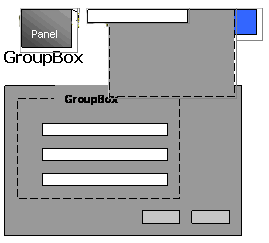One of the most powerful aspects of .NET and Windows Forms is data binding. Historically, data binding was used to bind views to data stored in databases. Some database management systems, such as Microsoft Access, have provided GUI APIs to help developers quickly bind to data.
This sample is taken from Chapter 6: "Windows Forms Data Binding" of the Blue Vision Title "Developing .NET Custom Controls and Designers using C#"






Binding and BindingContext
.NET Controls either support simple binding
or complex binding. Controls that support simple binding include the text
box. A text box can only support one data value at a time. The following example
shows how to bind a text box control with a name field of a Customers DataTable:
TextBox nameTextBox = new
TextBox();
DataSet dataSet = CreateMyDataSet();
nameTextBox.DataBindings.Add("Text", dataSet, "Customers.FirstName");
Binding
Every Windows Form control has a DataBindings property, which is an instance of ControlBindingsCollection.
The ControlBindingsCollection is a collection of
Binding objects, which bind the property of a control to a data source member.
Whenever the data source member changes, the control�s property is automatically
updated to reflect the change, and vice versa.
Different properties of the same control
may also be bound to different data sources.
BindingContext
Every container control on a Windows Form,
including a form itself, contains at least one BindingContext. Actually, all controls derived from System.Windows.Forms.Control
have the BindingContext property, but only container controls really make use of it. Non-container
controls will simply return the BindingContext of their immediate container. A BindingContext is just an object that provides binding support
to multiple data sources. Since more than one data source can be viewed on
a form, the BindingContext enables retrieval of
any particular data source. Specifically, a BindingContext
manages a collection of BindingManagerBase objects. BindingManagerBase is an abstract
class that enables synchronization of data-bound controls that are bound to
the same data source. A BindingContext can be visualized
as follows (The dashed lines represent the BindingContext):

In the pictures above, the BindingContext simply says, "I will manage
and keep track of all controls and their associated data sources and data-bound
members. If the current record in the one of the managed data sources changes,
I will refresh all controls that I track with the new values."
By default, only one BindingContext is created for a Form, regardless of the number of controls contained
on the form.
Here is the syntax for retrieving a data
source from the BindingContext:
BindingManagerBasecustomers = this.BindingContext
[dataSet, "Customers"];
Here is the syntax for creating a new
BindingContext.
groupBox1.BindingContext = new BindingContext();
groupBox2.BindingContext = new BindingContext();
In the snippet above, two BindingContext objects are created and are assigned to two group box controls. This
allows the contained controls in both group boxes to be bound to the same
data source, but using two different binding managers.
The two classes derived from BindingManagerBase are described next.
CurrencyManager
Any data source that is bound to a .NET Windows Forms control will be associated
with a CurrencyManager. Actually, the true name for CurrencyManager should be
"concurrency manager" or "current manager." During the days
of ADO, the collection itself kept track of the current record. The problem
with this approach was that multiple consumers could not reuse the same collection
concurrently in an efficient manner. For example, if there were two grid controls
on a dialog that used ADO to display their data, and if both grids used the
current record for highlighting purposes, there would be no way for each grid
to highlight a different item at the same time. With .NET, the current record
is not maintained in the data source itself, which makes the data source truly
disconnected. The current record is, instead, maintained by the CurrencyManager.
A CurrencyManager has a one-to-one relationship with a data source.
A CurrencyManager is automatically created when a Binding object is created, if it is
the first time that the data source has been bound. ( Remember
that there is only one CurrencyManager per data source per BindingContext.)
The following diagram shows the relationship
between a Form, Panel, CurrencyManager objects
, and data sources:

In the diagram above, the Form contains the automatically created BindingContext,
which contains two CurrencyManager objects, one managing an array, and the other
managing a collection. The Panel contains a newly created BindingContext (remember
that only the Form's BindingContext is created by default), which also contains
two CurrencyManager objects, one managing the same collection that is bound
to the Form, and the other managing a DataTable. Normally, only one CurrencyManager
would be created for the Collection; but since there are two BindingContext
objects, each must contain its own collection of CurrencyManager objects.
The following diagram shows control binding
in action:

In the diagram above, a particular control has three properties that are participating
in data binding, as we can note from the three Binding objects. These bindings
are stored in the control�s ControlBindings property, which is an instance of
ControlBindingsCollection. The ControlBindingsCollection class is a collection
of Binding objects. A Binding associates the property of a control with a data
source member. Whenever the data source member value changes, the control's
property is updated, and vice-versa. Two of the bindings are associated with
the same data source, while the third one is associated with a different data
source. The CurrencyManager ensures that the properties that are associated
with the same data source are synchronized.









Comments
Be the first to write a comment
You must me logged in to write a comment.